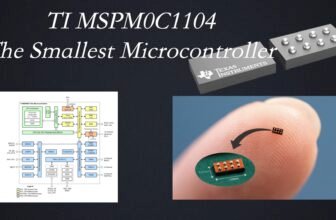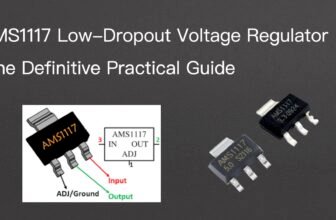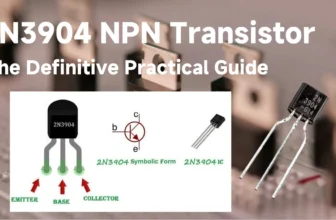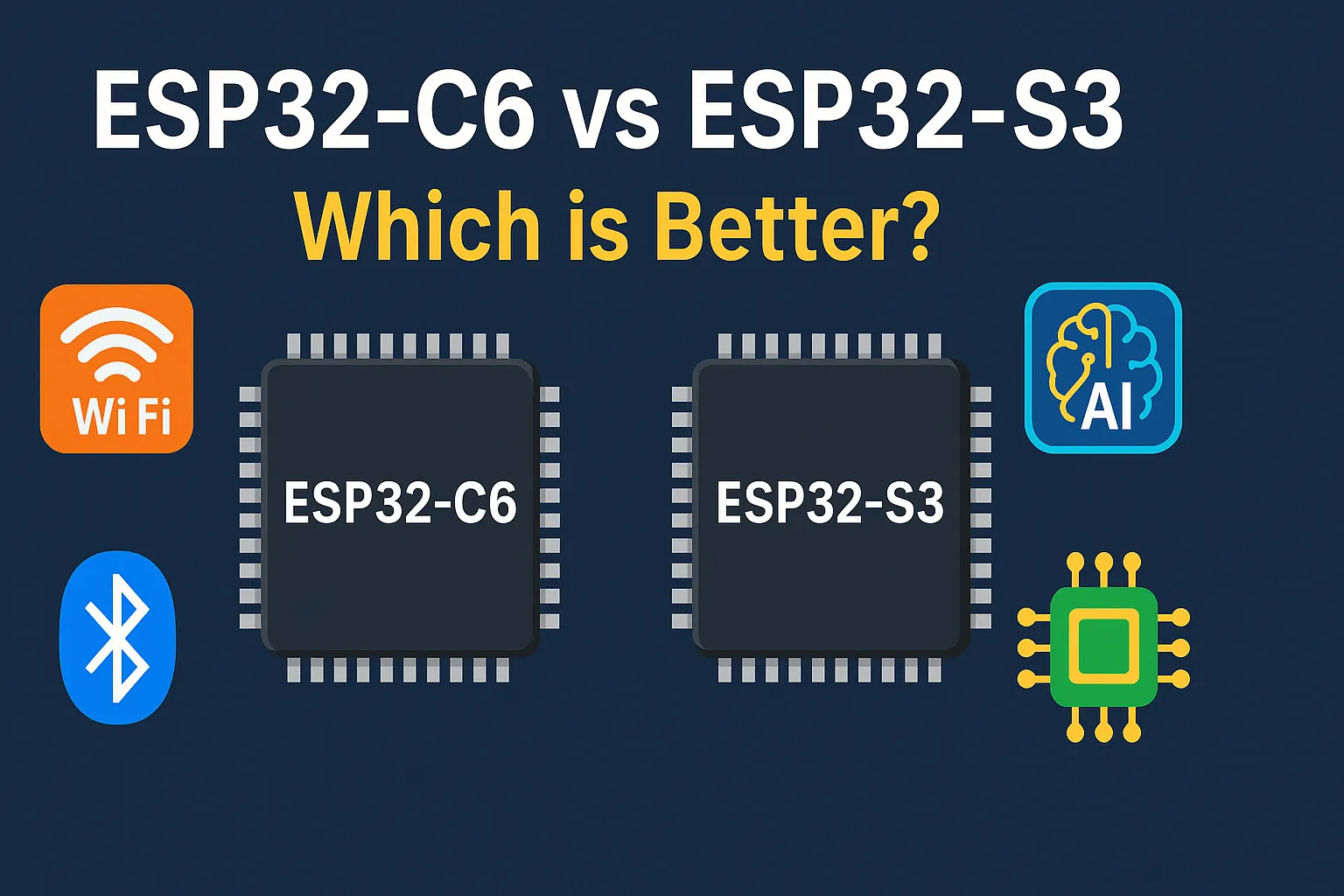
If you’re choosing between Espressif’s ESP32-C6 and ESP32-S3, you’re really choosing between modern connectivity and battery-savvy efficiency (C6) versus raw compute, rich peripherals, and AI-friendly features (S3). Both deliver Espressif’s trademark developer experience (ESP-IDF, Arduino core, solid tooling), but their silicon is tuned for different jobs.
Below is a deep, practical comparison to help you pick with confidence—covering cores, wireless stacks, memory, peripherals, power, security, ecosystem, and real-world use cases.
Executive Summary (TL;DR)
- Pick ESP32-C6 when you need Wi-Fi 6 features (OFDMA, TWT), Thread/Zigbee (802.15.4), and long battery life for Matter smart-home devices, dense Wi-Fi environments, or multi-radio coexistence. It’s a single-core RISC-V design up to 160 MHz with Bluetooth LE 5.3.
- Pick ESP32-S3 when you need more CPU headroom, vector/SIMD for ML/DSP, USB-OTG, camera/LCD, and lots of GPIO/ADC channels—think edge vision, audio, HMI, and maker projects that like moving pixels. It’s dual-core Xtensa LX7 up to 240 MHz with Bluetooth LE 5.
ESP32-C6 vs ESP32-S3: Quick Overview
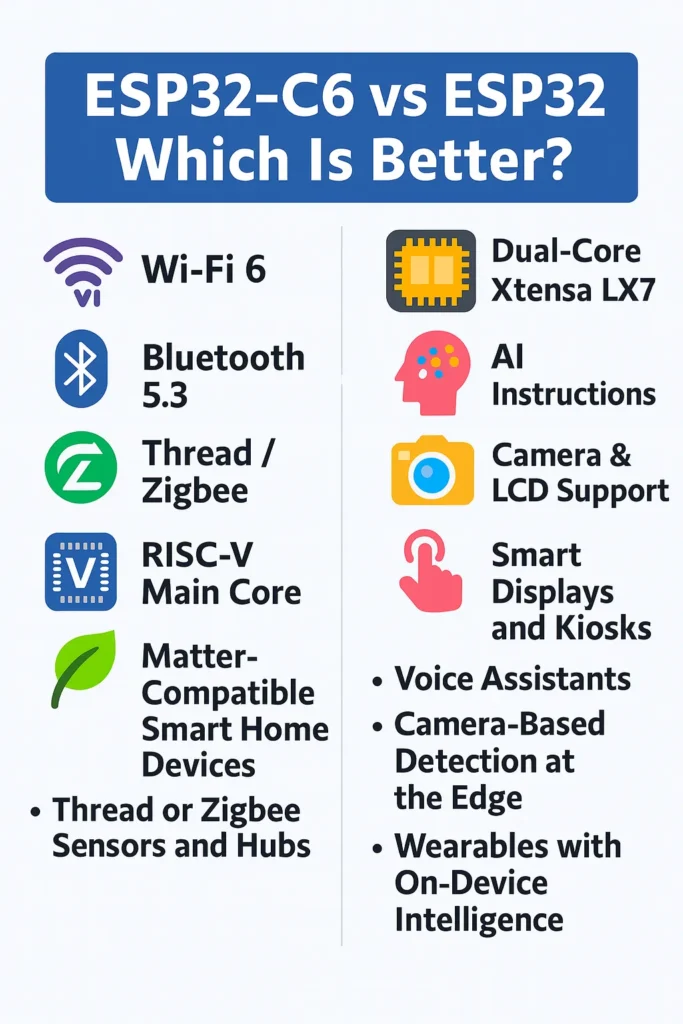
ESP32-S3 SOC Overview
The ESP32-S3 SOC is built for projects that need more compute and richer I/O. It pairs a dual-core Xtensa LX7 processor with AI-friendly vector instructions, and it natively supports cameras, LCD panels, and capacitive touch—so you can move pixels, process audio, and handle UI input without extra helper chips.
Key highlights
- Dual-core Xtensa LX7 with AI/vector instructions for DSP/ML tasks
- 512 KB SRAM on-chip, with optional PSRAM for frame buffers and larger models
- Native interfaces for DVP camera, RGB/I80 LCD, and touch sensing
- Ideal when you need graphics, audio/voice, or on-device intelligence
Great fit for
- Smart displays and kiosks (dynamic UI, animations, local UX logic)
- Voice assistants (keyword spotting, wake-word, basic NLU at the edge)
- Camera-based detection at the edge (motion, occupancy, simple vision)
- Wearables with on-device intelligence (gesture, health signals, haptics)
ESP32-C6 SOC Overview
The ESP32-C6 targets the next generation of connected products, combining Wi-Fi 6, Bluetooth 5.3, and Thread/Zigbee (802.15.4) on a single chip. That makes it a natural choice for Matter and other modern IoT stacks that benefit from multi-protocol flexibility and low-power scheduling.
Under the hood, it uses a high-performance RISC-V main core plus a second ultra-low-power core to handle background tasks while the system sleeps—balancing responsiveness with battery life. Memory includes 512 KB SRAM and additional low-power retention RAM for efficient always-on scenarios.
Key highlights
- Wi-Fi 6 (2.4 GHz) with modern efficiency features (great in dense networks)
- Bluetooth LE 5.3 plus Thread/Zigbee (802.15.4) for Matter-ready designs
- RISC-V main core + low-power companion core for duty-cycled operation
- 512 KB SRAM with extra low-power memory for background tasks
Great fit for
- Matter-compatible smart-home devices (bulbs, switches, locks)
- Thread or Zigbee sensors and hubs needing long life and robust links
- Multi-protocol routers and gateways consolidating radios on one SoC
- Industrial IoT where wireless flexibility and efficiency matter
ESP32-C6 vs ESP32-S3: Detailed Difference
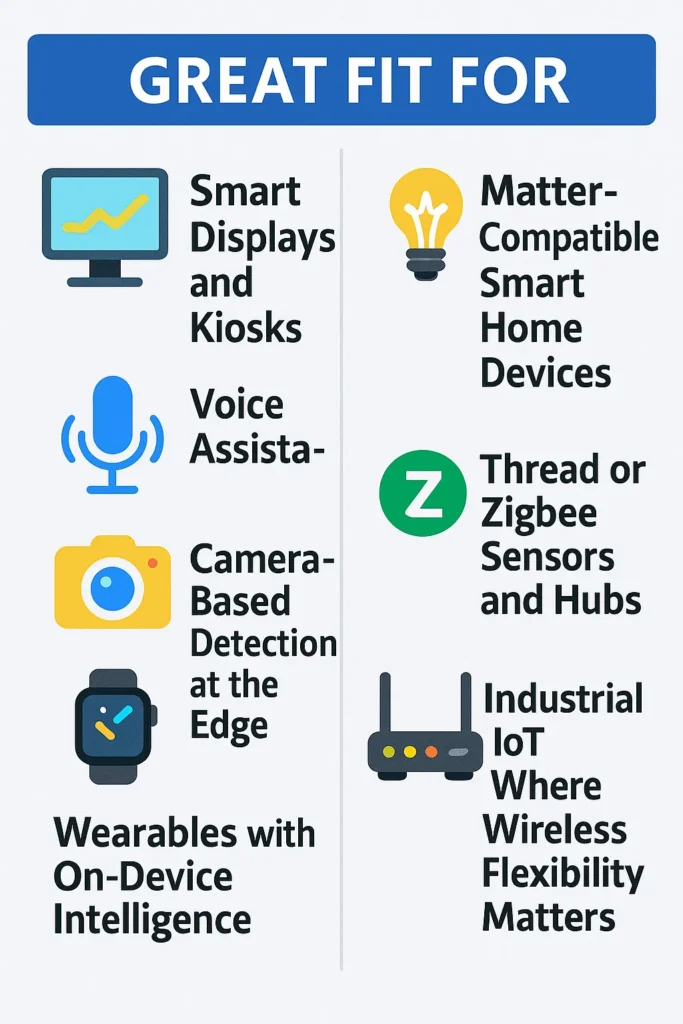
CPU & Compute
ESP32-C6 (RISC-V):
- One high-performance 32-bit RISC-V core up to 160 MHz, plus a low-power 32-bit RISC-V up to 20 MHz for background/always-on tasks. Espressif quotes ~497 CoreMark at 160 MHz for the HP core. The split HP/LP architecture helps minimize active and sleep power without sacrificing responsiveness.
ESP32-S3 (Xtensa LX7):
- Dual-core Xtensa LX7 up to 240 MHz with SIMD/vector instructions (handy for fixed-point DSP, audio, tiny ML). Datasheet lists ~1182 CoreMark for two cores at 240 MHz, or ~614 CoreMark for one core. If your workload includes FFTs, FIRs, keyword spotting, or image filters, S3’s compute wins decisively.
Bottom line: S3 is the compute and acceleration champ; C6 is optimized for efficient, always-connected devices.
Wireless Stack & Radios
Common ground: Both integrate 2.4 GHz Wi-Fi and Bluetooth LE, share a single RF front end with coexistence, and support multiple virtual interfaces for Station/SoftAP combos.
What’s different:
- Wi-Fi generation
- C6: Wi-Fi 6 (802.11ax) in 2.4 GHz with OFDMA, TWT (Target Wake Time), downlink MU-MIMO, and related robustness features. 11ax is limited to 20 MHz channels (STA mode); legacy b/g/n supports 20/40 MHz. If your product lives on congested 2.4 GHz networks or must coexist with many clients, C6’s ax features are a real upgrade.
- S3: Wi-Fi 4 (802.11b/g/n) up to 150 Mb/s (1T1R). Great for most maker and consumer HMI projects, but not ax-class efficiency.
- Bluetooth
- C6: Bluetooth LE 5.3 (advertising extensions, Coded PHY, LE power control).
- S3: Bluetooth LE 5 (mesh support).
- 802.15.4 (Thread/Zigbee)
- C6: Built-in IEEE 802.15.4 radio with Thread 1.3 and Zigbee 3.0—this is the door to Matter multi-protocol products (Wi-Fi + Thread).
- S3: No 802.15.4 block on the SoC. (You can add an external 802.15.4 coprocessor, but it raises cost/complexity.)
Bottom line: For Matter/Thread, dense Wi-Fi, and modern BLE features, C6 is the right tool. For classic Wi-Fi + BLE use and richer peripherals, S3 is excellent.
Memory & Storage
- ESP32-C6: 512 KB SRAM (HP) + 16 KB LP SRAM, 320 KB ROM, external SPI/QSPI/QPI flash; internal cache controller.
- ESP32-S3: 512 KB SRAM, 384 KB ROM, octal-SPI (OPI) support for high-speed external flash and PSRAM, which is a big deal for displays, cameras, and buffering.
Bottom line: On-chip SRAM is similar, but S3’s high-speed Octal-SPI PSRAM option makes large frame buffers and ML models much more comfortable.
Peripherals, I/O & Media
ESP32-C6 highlights
- GPIO: up to 30 (QFN40) or 22 (QFN32).
- ADC: 12-bit SAR, up to 7 channels.
- Interfaces: SPI, I²C, I²S, UART (2), RMT, MCPWM, SDIO 2.0 slave, PARLIO (parallel I/O), LED-PWM, PCNT, GDMA, TWAI (CAN).
- Designed more like a network-centric MCU; no native LCD or camera port.
ESP32-S3 highlights
- GPIO: up to 45.
- ADC: two 12-bit SAR ADCs, up to 20 channels.
- Display/Camera: Parallel LCD (RGB/I8080/6800) + DVP camera interface; built-in color space helpers (RGB↔YUV).
- USB: Full-speed USB-OTG (+ separate USB-Serial/JTAG).
- Storage: SD/MMC host with two slots.
- Other: touch sensing (14), more UART/I²C/I²S instances, GDMA (5 TX/5 RX), TWAI (CAN).
Bottom line: If your design says “screen + camera + USB + lots of ADC pins,” S3 is tailored for it. If it says “compact IoT radio that speaks Wi-Fi 6 and Thread,” C6 has exactly what you need.
Power & Sleep Behavior
Both families implement fine-grained clock gating and multiple sleep states. C6 adds Wi-Fi 6’s TWT, which lets a station negotiate sleep windows with an ax access point—this can strongly reduce duty cycle in chatty networks. Espressif specifies ~7 µA Deep-sleep on C6, with LP memory retained. (Real-world numbers depend on boards and external electronic components.)
The S3 PMU and ULP coprocessors (including a ULP-RISC-V) enable sensor-driven wakeups and background tasks without the main cores. For camera/audio devices that wake on motion/voice, S3’s ULP plus vector instructions makes it easier to stay asleep longer, then sprint through the heavy lifting.
Security
Both SoCs include secure boot, flash encryption (XTS-AES), RNG, HMAC, Digital Signature, RSA/AES/SHA accelerators, and eFuse configuration—sufficient for production-grade device identity and encrypted OTA.
Development Ecosystem & Learning Curve
- Tooling: ESP-IDF (C/C++), Arduino core, and extensive examples support both chips. C6 uses RISC-V (GCC/LLVM), while S3 uses Xtensa toolchains; both are mature in ESP-IDF.
- Board options: Super-mini and module ecosystems (WROOM/MINI) exist for both; hobbyist reviews often note S3 development boards ship with more media-friendly breakouts, while C6 Evaluation Boards target connectivity stacks (Matter/Thread/Wi-Fi 6).
- Comparisons in the wild: Community and vendor write-ups consistently frame S3 as the “AI/vision/HMI” part and C6 as the “Wi-Fi 6 + 802.15.4” IoT part—useful for first-pass selection.
Power Design Notes
- C6 + Wi-Fi 6 AP: You’ll only realize TWT/OFDMA benefits if the access point supports 2.4 GHz ax scheduling. Validate battery life with the actual AP model you target—office vs home APs can behave differently.
- S3 in “bursty compute” roles: Use the ULP-RISC-V and event-driven wakeups (GPIO/RTC/touch) to park the big cores, then process quickly using SIMD and go back to sleep.
- External PSRAM (S3): Budget PSRAM’s leakage into your sleep current—some modules gate PSRAM power with a load switch for deep-sleep scenarios. (Board-level practice; check your module’s datasheet.)
Security & Production
Both families provide the primitives you need for secure boot, encrypted firmware/assets, device identity, signed updates, and TLS acceleration. Plan your eFuse map early (secure boot revocation, flash-encryption keys) so you don’t paint yourself into a corner.
Ecosystem & Boards
- The SuperMini class boards make it easy to prototype both C6 and S3; you’ll find that S3 variants often expose camera/LCD pins, while C6 variants emphasize compactness and low-power radio projects. Community guides compare pinouts, battery headers, and examples side-by-side.
- For a broader family overview (C3, S3, C6, H2, etc.), community round-ups track release timelines and typical use-cases—useful if you might swap parts later.
- Some third-party summaries also frame the S3 vs C6 trade-offs at a high level (ML/HMI vs Wi-Fi 6/Thread), which aligns with Espressif’s own positioning. Use these as sanity checks when speccing prototypes.
ESP32-S3 vs ESP32-C6: Spec-for-Spec Quick Look
| Category | ESP32-C6 | ESP32-S3 |
|---|---|---|
| CPU | 1× RISC-V HP @ up to 160 MHz + 1× LP RISC-V @ up to 20 MHz | 2× Xtensa LX7 @ up to 240 MHz |
| CoreMark | ~497 (HP @ 160 MHz) | ~1182 (dual @ 240 MHz) / ~614 (single @ 240 MHz) |
| Wi-Fi | Wi-Fi 6 (802.11ax) @ 2.4 GHz (20 MHz STA); legacy b/g/n 20/40 MHz | Wi-Fi 4 (802.11b/g/n) @ 2.4 GHz, 20/40 MHz |
| Bluetooth | LE 5.3 | LE 5 (mesh) |
| 802.15.4 | Yes (Thread 1.3, Zigbee 3.0) | No |
| SRAM (on-chip) | 512 KB HP + 16 KB LP | 512 KB |
| External memory | SPI/QSPI/QPI flash | SPI/Dual/Quad/Octal-SPI flash + PSRAM (OPI) |
| GPIO (max) | 30 (QFN40) | 45 |
| ADC | 12-bit, up to 7 ch | 12-bit ×2, up to 20 ch |
| Media I/O | — | LCD RGB/I8080, DVP camera, SD/MMC host |
| USB | USB-Serial/JTAG | USB-OTG (FS) + USB-Serial/JTAG |
| Notables | OFDMA, TWT, MU-MIMO (DL) | SIMD/vector, touch, GDMA 5×TX/5×RX |
Real-World Project Guidance
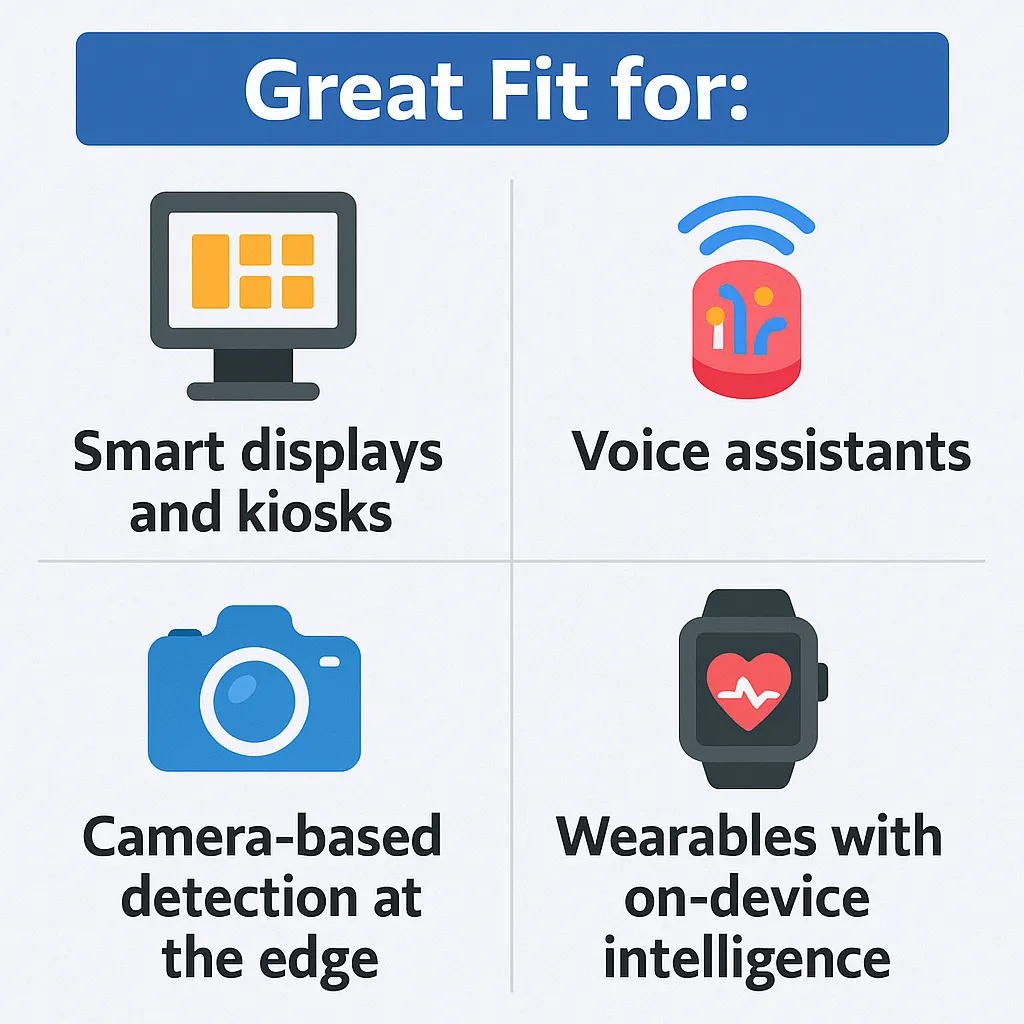
When ESP32-C6 is the better pick
- Matter & Multi-Protocol Hubs
Need Wi-Fi + Thread on one SoC for a single-SKU smart-home device? C6’s 802.15.4 radio and Wi-Fi 6 coexistence make it straightforward. BLE 5.3 helps for commissioning. - Battery IoT in Crowded 2.4 GHz
Sensors and buttons that wake rarely yet must stay reliably connected—TWT reduces airtime, OFDMA improves spectral efficiency when many clients contend. - Industrial Sensors with Deterministic Sleep
The LP RISC-V can run housekeeping while the HP core sleeps; 7 µA Deep-sleep target (SoC-level) is favorable for multi-year coin-cell designs—board-level design permitting.
When ESP32-S3 is the better pick
- Edge AI & Audio/Voice
Dual cores plus SIMD make it easier to run MFCCs, keyword spotting, or classical CV on grayscale frames; you can keep one core for networking/UI and the other for DSP. - Camera + Display + USB Gadgets
DVP camera, LCD RGB/I8080, USB-OTG, and SD/MMC give you a complete “smart camera” or HMI terminal without extra bridges. Add Octal-SPI PSRAM to buffer frames. - Maker-Friendly Mixed-Signal Projects
45 GPIOs, 20 ADC channels, touch sensors, and abundant timers/DMA make the S3 feel like a Swiss Army knife for complex breakouts and shields.
Conclusion
The ESP32-C6 modernizes 2.4 GHz Wi-Fi with ax-class efficiency and adds 802.15.4 for Matter/Thread, making it a natural fit for connected, battery-powered devices that must behave well in dense networks. The ESP32-S3, by contrast, is the edge-compute workhorse: it marries dual-core horsepower and vector instructions with USB, camera, LCD, and abundant analog/digital I/O—ideal for vision, audio, and HMI.
If your product spec starts with protocols and power, go ESP32-C6. If it starts with pixels and processing, go ESP32-S3.
Choose ESP32-C6 if you need:
- Wi-Fi 6 efficiency (OFDMA, TWT) in crowded 2.4 GHz
- Thread/Zigbee (802.15.4) on the same chip as Wi-Fi/BLE
- BLE 5.3 features (Coded PHY, extended advertising)
- A lean, battery-first connected device
Choose ESP32-S3 if you need:
- Dual-core compute with SIMD for ML/DSP
- USB-OTG, camera, LCD, SD/MMC
- Lots of GPIO/ADC and touch sensing
- High-speed Octal-SPI PSRAM for frame buffers/models


